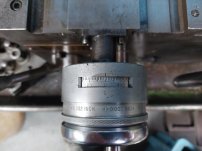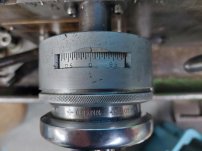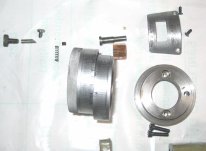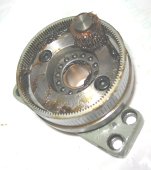Howie Dines
Plastic
- Joined
- Sep 17, 2020
- Location
- Germany (Formally UK)
Hi all, I just wanted to share an observation about my 6_1/2" master. (Mch. No. F 3/73617X .. 1972)
I'm in the process of making the missing parts for a taper attachment for the lathe. One item is the cross slide screw which is a dual start LH acme thread and appears to be 10TPI.
But this then got me thinking, is it actually metric or imperial as I have the sliding hand wheels to move from Metric to Imperial. Also on the headstock I have the lever to switch between MM & Inch for thread cutting.


Inch dial shows 0.400" per turn (Diameter) 0.200" in actual slide travel from dial
mm dial shows 10mm per turn (Diameter) 5mm in actual slide travel from dial
So which is actually correct?
I don't yet have a DRO, but it was easily sorted by measuring the real movement for 30 turns of the hand wheel.
152.63mm which would calculate to 6.0090"
152.63/5mm = 30.526 turns
6.009"/0.200 = 30.045 turns.
Therefore the screw must be imperial.
The Imperial scale handwheel is true and the mm scale is really out by 0.08mm (3 throu) per turn on the diameter of the part.
Conclusion:- Until I fit a DRO, carry on physically measuring when getting close to final size.
All the best, Howie
I'm in the process of making the missing parts for a taper attachment for the lathe. One item is the cross slide screw which is a dual start LH acme thread and appears to be 10TPI.
But this then got me thinking, is it actually metric or imperial as I have the sliding hand wheels to move from Metric to Imperial. Also on the headstock I have the lever to switch between MM & Inch for thread cutting.


Inch dial shows 0.400" per turn (Diameter) 0.200" in actual slide travel from dial
mm dial shows 10mm per turn (Diameter) 5mm in actual slide travel from dial
So which is actually correct?
I don't yet have a DRO, but it was easily sorted by measuring the real movement for 30 turns of the hand wheel.
152.63mm which would calculate to 6.0090"
152.63/5mm = 30.526 turns
6.009"/0.200 = 30.045 turns.
Therefore the screw must be imperial.
The Imperial scale handwheel is true and the mm scale is really out by 0.08mm (3 throu) per turn on the diameter of the part.
Conclusion:- Until I fit a DRO, carry on physically measuring when getting close to final size.
All the best, Howie




